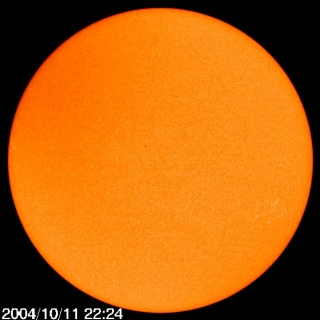 |
|||||
|
October 18, 2004: Six … long … years. Solar physicist David Hathaway has been checking the sun every day since 1998, and every day for six years there have been sunspots. Sunspots are planet-sized "islands" on the surface of the sun. They are dark, cool, powerfully magnetized, and fleeting: a typical sunspot lasts only a few days or weeks before it breaks up. As soon as one disappears, however, another emerges to take its place. Even during the lowest ebb of solar activity, you can usually find one or two spots on the sun. But when Hathaway looked on Jan. 28, 2004, there were none. The sun was utterly blank.
It happened again last week, twice, on Oct. 11th and 12th. There were no sunspots. "This is a sign," says Hathaway, "that the solar minimum is coming, and it's coming sooner than we expected." Left: The blank sun on Oct. 11, 2004, photographed by the ESA/NASA Solar and Heliospheric Observatory. Solar minimum and solar maximum--"Solar Min" and "Solar Max" for short--are two extremes of the sun's 11-year activity cycle. At maximum, the sun is peppered with spots, solar flares erupt, and the sun hurls billion-ton clouds of electrified gas toward Earth. It's a good time for sky watchers who enjoy auroras, but not so good for astronauts who have to be wary of radiation storms. Power outages, zapped satellites, malfunctioning GPS receivers--these are just a few of the things that can happen during Solar Max. Solar minimum is different. Sunspots are fewer--sometimes days or weeks go by without a spot. Solar flares subside. It's a safer time to travel through space, and a less interesting time to watch polar skies. Hathaway is an expert forecaster of the solar cycle. He keeps track of sunspot numbers (the best known indicator of solar activity) and predicts years in advance when the next peaks and valleys will come. It's not easy: "Contrary to popular belief," says Hathaway, "the solar cycle is not precisely 11 years long." Its length, measured from minimum to minimum, varies: "The shortest cycles are 9 years, and the longest ones are about 14 years." What makes a cycle long or short? Researchers aren't sure. "We won't even know if the current cycle is long or short--until it's over," he says.
|
|||||
|
(c) Copyright 1993-2007 J Sherwood |
|||||
